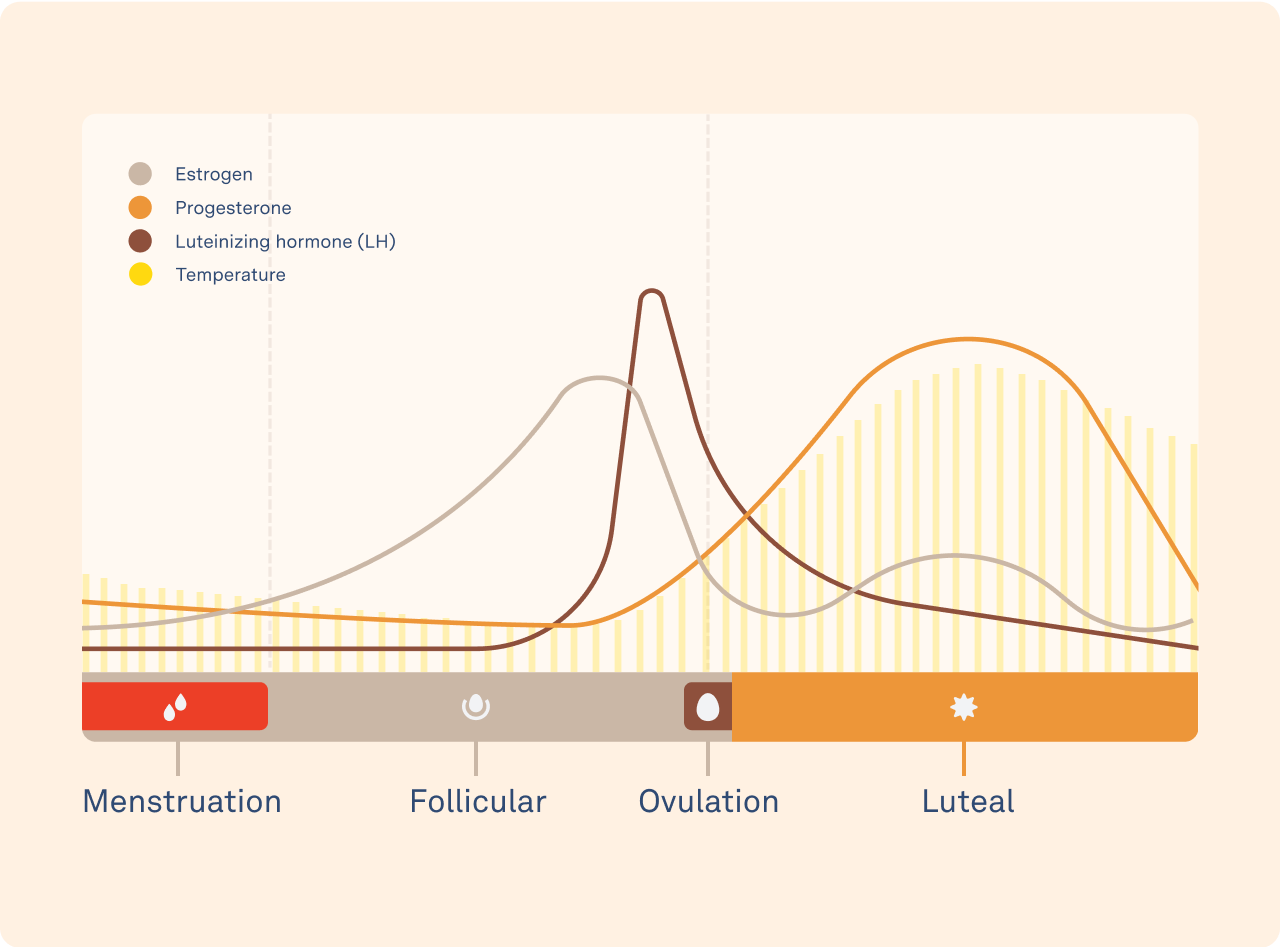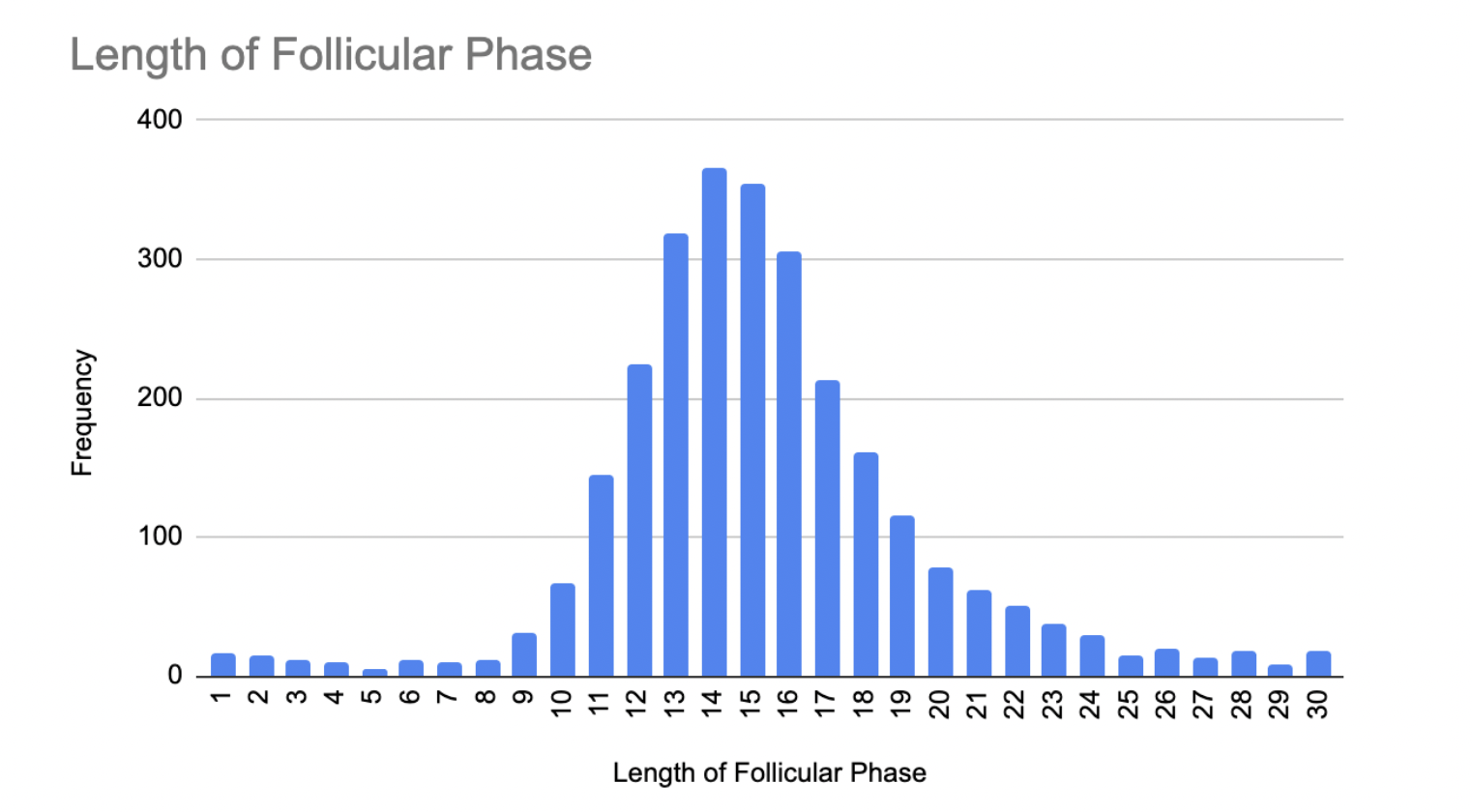Written by: Cristina Noujaim, Dr. Neta Gotlieb, and Dr. Nina Thigpen
If you’ve heard that ovulation occurs halfway through, or on day 14, of your menstrual cycle, you’re not alone. In fact, most depictions of cycle mapping or the fertility window tend to look like this graph as:

While it’s common to see ovulation predicted exactly 14 days after the start of your period, this isn’t true for everyone! The myth about ovulation occurring on day 15 comes from the myth about cycles being 28 days long. That may be true on average, but research by Natural Cycles on 600k+ cycles shows only 13% of people with cycles have a 28-day cycle.
What is Ovulation?
Let’s back up for a moment. As a refresher, ovulation occurs when a mature egg is released from the ovary. After release, the egg travels down the fallopian tube toward your uterus, where it stays for 12 to 24 hours, and where it can be fertilized. And while this process does occur about halfway through your cycle, it’s certainly not as exact as the 15th day for every person who menstruates.
The idea that ovulation occurs halfway through your cycle can be ascribed to logic that, on average, the cycle can be divided in two “equal” halves: the follicular phase and the luteal phase. But these two halves are typically not evenly divided. In fact, the luteal phase can range from the last 12 to 16 days of the cycle, while the follicular phase is even more variable in length, both within and among individuals.
RELATED: New to Oura: Cycle Insights
When Do Oura Members Ovulate?
Based on aggregated and de-identified data from 2,500 Oura members who have logged their ovulation, here is the distribution of length of the follicular phase (time between day one of period and ovulation):

As the chart shows, the typical number of days between period onset and ovulation for Oura members ranges from about 8 days up to 25 days. (“Frequency” signifies the number of members who logged that number of days.)
Note that Oura is committed to protecting our members’ privacy. You can read more about how Oura protects your data here.
LEARN MORE: Oura’s Commitment to Reproductive Health
Why is Knowing Your Precise Ovulation Date Important?
Your fertile window is determined by ovulation, so knowing the exact date is incredibly important!
After ovulation, the egg is viable for roughly 24 hours, so for people trying to conceive, knowing precisely when they are most fertile is key to improving success rates. Your fertile window, however, begins prior to ovulation, because sperm is viable in the female body for up to 5 days. Whether the goal is conception or contraception, knowing exactly when this window occurs helps take the appropriate actions while minimizing risks for undesired outcomes.
What Impacts the Length of Menstrual Cycles?
Many factors can lead to variations in the length of a menstrual cycle. Typically, the causes behind variations in cycles are more complex than one specific factor having an all or none impact and usually these contributors are tied together with other contributors and balances.
Age: In general, with increasing age, cycle length reduces and the timing of ovulation becomes earlier. The variation in cycle length also lessens with age until around the age of 40, when most people who menstruate enter the journey of perimenopause and menopause, and when cycles become more variable.
Pregnancy: Periods stop during pregnancy because the ovaries no longer release eggs.
Breastfeeding: For some women, periods do not return until after breastfeeding ends. For others, periods may resume within a few months of giving birth. Given this variability, and because ovulation (hence potential for pregnancy) happens before menstruation, doctors do not recommend using breastfeeding as a contraceptive method!
Excessive exercise: Note that while some studies have found that exercise impacts the menstrual cycle, others have not. In one study, physical activity of 4 or more hours per week was associated with an increased cycle length, “which could be due to a dampening of FSH pulses during the luteal-follicular transition, leading to delayed maturation of the next cohort of follicles,” according to the study authors.
Also noteworthy: Other research finds reduced menstrual symptoms in women who exercise, and some studies show that regular exercise can improve some symptoms of premenstrual syndrome (e.g., mood disturbance, fatigue, cognitive dysfunction, and bloating).
Stress: Studies show that psychosocial factors can carry an impact on women’s health generally, and on the menstrual cycle in particular. Anxiety, perceived stress, and depressive symptoms are associated with increased prevalence of menstrual cycle irregularity.
Body weight: Being overweight is associated with a higher probability of long cycles. Studies show that women with a BMI greater than 25 have a higher possibility of developing irregular menstruation. Additionally, women who are underweight have a slightly higher probability of developing menstrual cycle irregularity than those with BMI of 20–25 BMI.
Chronic medical conditions and acute illness: Certain medical conditions, including thyroid issues, hyperprolactinemia, or polycystic ovary syndrome (PCOS), are also known to cause irregular periods.
Cigarette smoking: Smoking is associated with a significant decrease in average follicular phase length, while lifetime smoking was also correlated with early menopause.
Marijuana use: Occasional and frequent marijuana use are associated with longer follicular phases.
Alcohol consumption: Drinking alcohol has been shown to lead to a reduction in long cycles and changes in hormone dynamics.
Other factors could include catastrophic events (e.g. war), large fluctuations in weight, disordered eating or famine, or certain medications.
RELATED: How Oura Data Can Help You Understand Your Menstrual Cycle
About the Oura Experts:
Cristina Noujaim is a Machine Learning Data Scientist at ŌURA. She currently works on designing and implementing AI algorithms to democratize health. Cristina previously worked at Meta, where she developed state-of-the-art machine translation models for Meta’s 2 billion users. She received her degrees from the University of Michigan, where she researched multi-modal question answering.
Neta Gotlieb, Ph.D., is a Lead Clinical Research Scientist at ŌURA researching and developing solutions focused on women’s health. Her mission and passion is to solve challenges related to reproductive health and empower ŌURA users to make informed, data-driven decisions. Before joining ŌURA, she worked at a nonprofit organization as their Head of Volunteering Programs, but her passion for scientific discovery inspired her to pursue a career as a research scientist. Gotlieb received her Master’s degree from Tel Aviv University in Biological Psychology where her work focused on how stress impacts immune function. She then earned a PhD from UC Berkeley where she studied Reproductive Endocrinology and the circadian regulation of menstrual cycles, pregnancy, and birth. Outside of work, Neta enjoys hiking, biking, and spending time with her family. She lives in the Bay Area with her husband and two children.
Nina Thigpen, Ph.D. is a Lead Machine Learning Data Scientist at ŌURA. She currently develops AI algorithms that empower people to track and improve their health using the ŌURA ring. Dr. Thigpen previously developed AI applications in wearable and neuroscience technologies at Google X. She received her Ph.D. in Behavioral and Cognitive Neuroscience from the University of Florida, where she researched computational models for better representing and combining eye-tracking, cardiac, and brain data.











